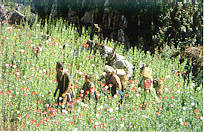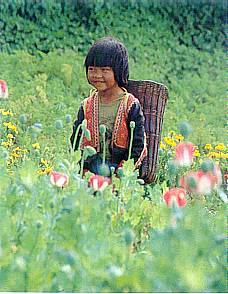
Window to Chiang Mai Thailand

Window to Chiang Mai Thailand
Elephant Care & Trekking Tours
Opium originated in the Mediterranean region and was first brought to the east by Arab traders around the seventh century AD. It came to Thailand when hilltribes migrated south from Yunnan, where opium growing had been encouraged to stop British control of the trade in the 19th century.
 Though opium consumption in Siam from the late 19th century was controlled by a royal monopoly and was a useful source of income, it was never approved of. In 1959 poppy cultivation was made illegal, but by 1967 Thailand was still producing 145 tons due to the corrupting influence of the Vietnam War.
Though opium consumption in Siam from the late 19th century was controlled by a royal monopoly and was a useful source of income, it was never approved of. In 1959 poppy cultivation was made illegal, but by 1967 Thailand was still producing 145 tons due to the corrupting influence of the Vietnam War.
Intensified Western efforts to stop the drug epidemic resulted in the cash crop substitute program, and by 1995 annual opium production in Thailand was estimated to be only 17 tons. However, the cost of the opium eradication program has been high. Opium addicts have turned to heroin and HIV has followed the use of the needle. Toxic pollution from heavy use of pesticides has been widespread. Worse is the fact that opium production is virtually out of control beyond Thailand's borders.
The Thai government remains determined to prevent large-scale opium production within its borders, and the Third Army destroys plantations annually. The 1959 law covers not just opium, however, but all narcotics. Penalties for possession of just small amounts of heroin are very heavy - a fact which foreigners ignore at their own risk!
 The main cultivators of the opium poppy are the Hmong, Yao, Lahu and Lisu. The plant likes altitudes above 850 meters near limestone ridges or below cliffs. Fields are cleared early in the hot season (March) and burnt. Then a fast-growing crop like corn is planted. The poppy is sown in September and plants thinned out in November.
The main cultivators of the opium poppy are the Hmong, Yao, Lahu and Lisu. The plant likes altitudes above 850 meters near limestone ridges or below cliffs. Fields are cleared early in the hot season (March) and burnt. Then a fast-growing crop like corn is planted. The poppy is sown in September and plants thinned out in November.
Vegetables are grown to add minerals to the soil as well as supplement the diet. They also help to hide the opium plants.
The vegetables are cleared and the plants begin to flower in January. When the petals drop off the pods, farmers slit them in a way that causes the resin to ooze out and congeal on surface. The sticky congealed opium is scraped off a day later.
The cash from the sale of opium is still important for hilltribe cultivators, who traditionally have used the drug themselves mainly for medicinal purposes.
Addiction, however, has been a curse that eventually leads to dire poverty.